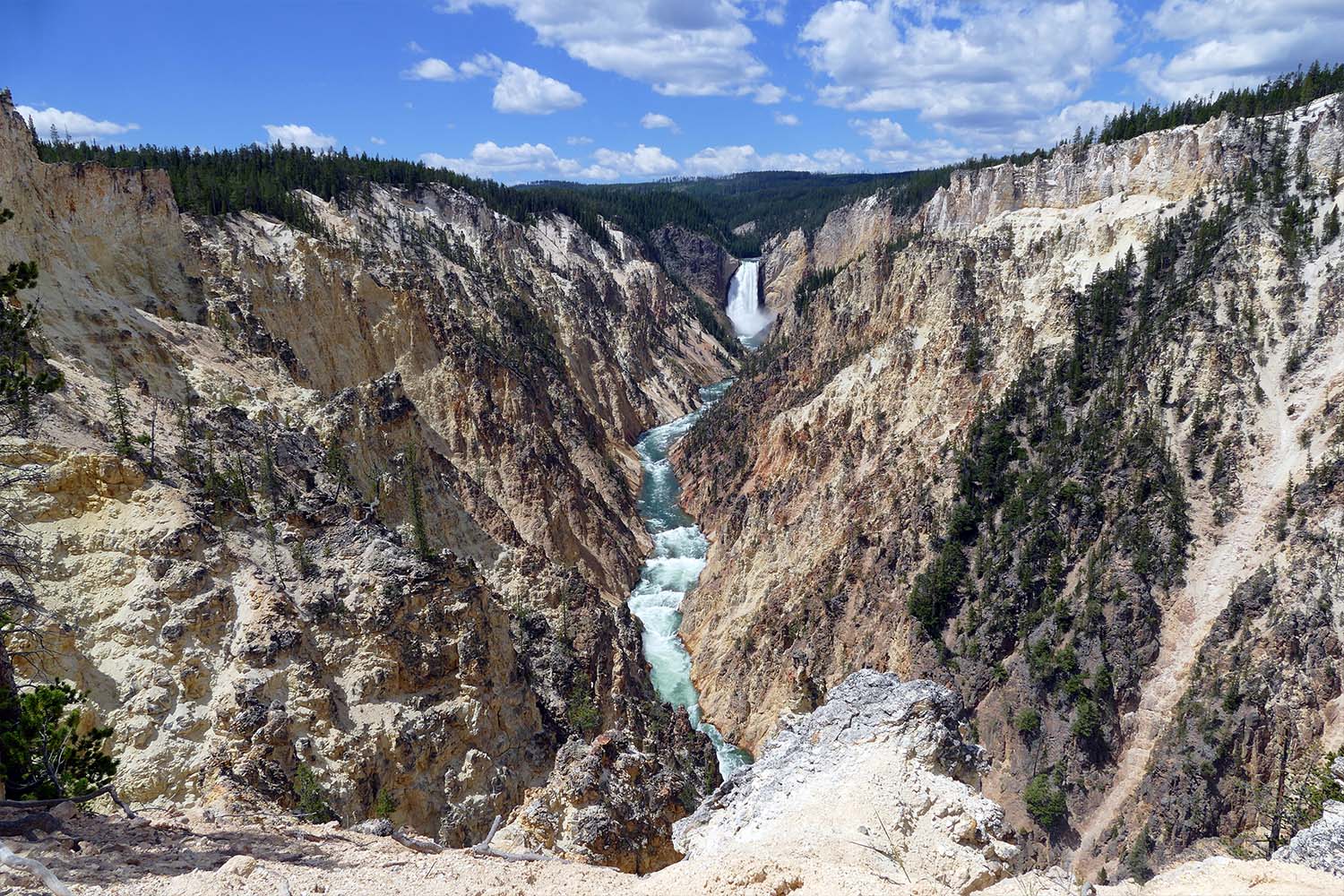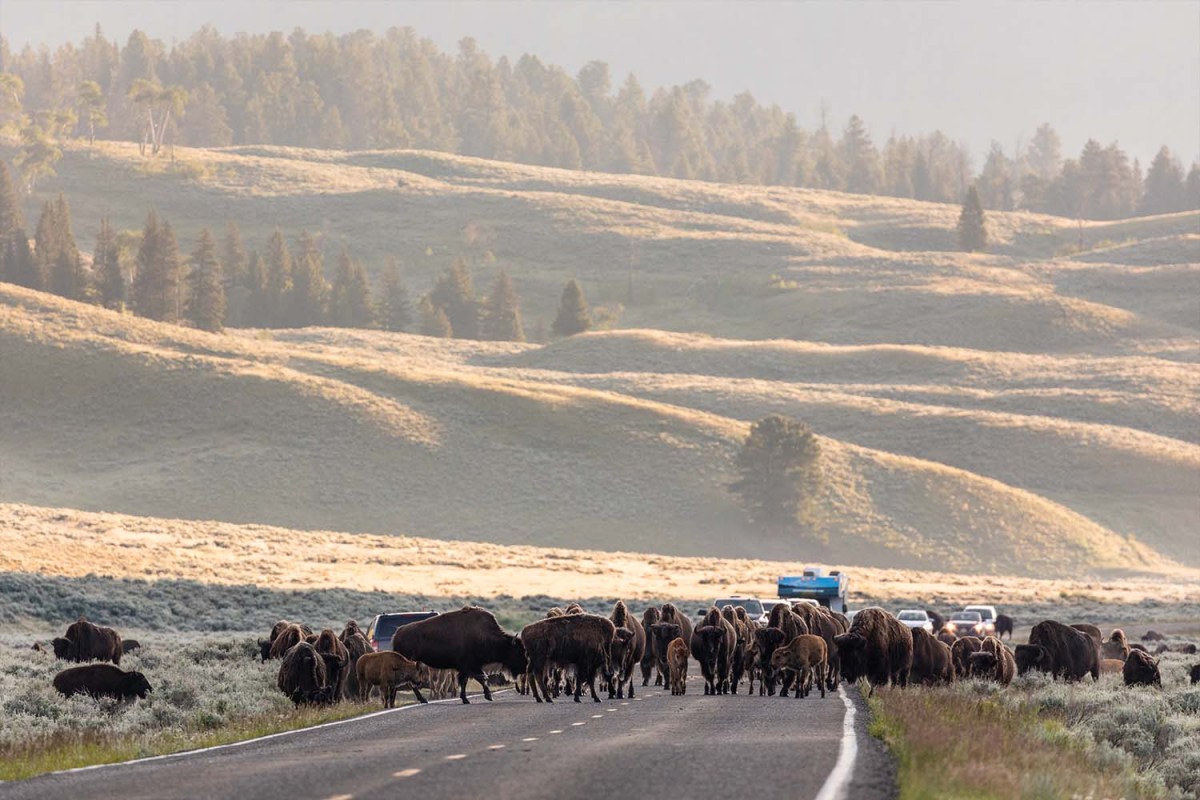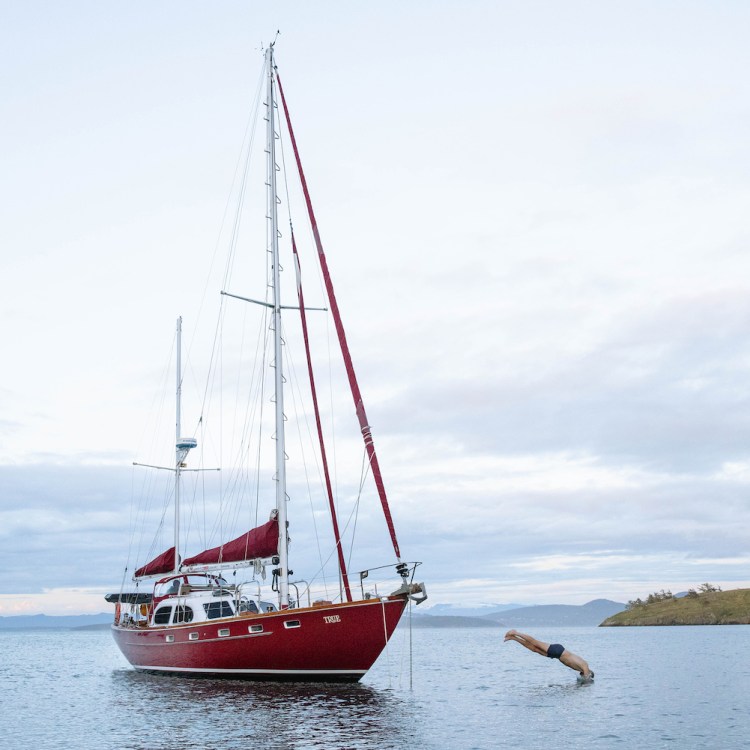Let’s start with the obvious: Yellowstone National Park is massive. At 3,427 square miles — larger than Rhode Island and Delaware combined — the park is the second largest in the lower U.S., after Death Valley, and dwarfed only by the Alaskan heavy hitters including Wrangell-St. Elias and Denali. It takes hours to drive across the park, and one of its prime routes, the Grand Loop, might take you up to seven hours. If you’re staying outside the park, you could easily tack on an hour commuting.
That kind of scale means that getting the most out of your visit requires a lot of research — where to stay, meals, logistics and what you want to focus on seeing. I sidestepped all of that by booking a tour.

Yellowstone Forever — the park’s official nonprofit, which runs several educational programs from within — is the best idea we ever had. From winter through summer, Yellowstone Forever’s team of guides run day trips — seasonally using specially equipped vehicles to deal with the snow and access areas no 4×4 could reach — round-tripping it out of its Gardiner, Montana headquarters, where the focus can be everything from wildlife spotting to photography to hiking.
But it’s the Lodging & Learning programs that set themselves apart because you actually get to sleep in the park. Overnighting in Yellowstone, which means staying at a lodge run by Xanterra, adds an interesting layer to the trip, especially at night when you can take advantage of programs given by National Park Service rangers.

With my wife and 12-year-old daughter in tow, I visited the park for the first time through the Lodging & Learning’s Yellowstone for Families package. The annual program, which runs every week from about Memorial Day to mid-August, clusters a group of up to 13 people, including kids as young as eight, with a Yellowstone Forever field guide for three full days in the park, bookended by travel days. The tour aims to explain the history of the park, from the bacteria and geology to the Native Americans and wildlife that inhabited the area in a way that is informative for adults and engaging for kids. Youngsters get an activity book they complete before the final day’s swearing-in as junior rangers.

The package includes four nights in Grant Village, your base on the shore of West Thumb bay of Yellowstone Lake, in the southeast corner of the park. Reaching it is about a 90-minute drive north from Jackson Hole Airport, the closest and easiest route coming from the East Coast. The rooms at Grant Village are clean and comfortable but come sans TV or wifi. Cellular reception in the park is spotty and almost nonexistent at Grant Village, though I did manage to get online by turning my Verizon iPhone into a hotspot around 5:00 a.m. — until everyone else started scrolling and the bandwidth couldn’t keep up.

The lodge has two restaurants, the Lake House and Grant Village Dining Room, both on the water. You visit the handsome dining room, festooned with timbers and a massive wall of windows, for breakfast which, like the deli lunch provided on the road, is covered by the program’s fee. You’re on your own for dinner, and the dining room or Lake House are the nearest options. But since the tours end most days at around 4:00 p.m., you can freshen up and drive to other areas of the park for a change of scenery over dinner. Those drives can range from 35 minutes to well over one hour each way.
Cheyenne, Wyoming, Is an Honest Look at the American West
The city behind the famous horse-bucking cowboy emblem holds onto its Wild West past
After checking in on the first night, we met our guide and the other families touring with us during orientation where we discussed the week’s itinerary. The first morning started with a meeting at the Yellowstone Forever bus for a drive north to the Hayden Valley, which on this day was filled with bison during mating season. It didn’t take long to spot the first elk, which our guide called out while she was driving through her headset. While about 80% of Yellowstone is forested, Hayden Valley, split in two by the Yellowstone River, is a vast meadow of rolling hills and thermal features that make it almost a surefire bet to see bison. We spotted bison, elk, heron, ducks and geese, but you might also see predators like bears, wolves, coyotes and foxes.

Then it was off to the 10,219-foot summit of Mount Washburn and the panoramic view of around 50 miles, including spotting one of the three fire lookout stations in the park. We were making our way to Tower Falls, and the short hike down the trailhead to an overlook of the Yellowstone River, which was a nice break from sitting on the bus. The park is home to some 300 waterfalls, but the drama of the 132-foot drop of Tower Falls played a pivotal role in Yellowstone’s history. When paintings of the falls, by artist Thomas Moran, reached Congress, it helped convince them to make Yellowstone the first national park.
After lunch in the van, we pulled over to spot a black bear den through some binoculars our guide provided. Then the conversation turned towards dinner. While standing reservations are made for you at the nearby Grant Village Dining Room, I booked a table at the Old Faithful Inn’s dining room instead, which is about a 35-minute drive away from our lodgings. This particular inn offers maybe the best seat in all of Yellowstone: With a beer in hand, you can sit there on the covered viewing deck watching Old Faithful go off while waiting for your dinner reservation to kick in. Retiring to our room at Grant Village, with the window open and a breeze coming in off the lake, it was a solid night’s sleep after a long day of touring.

The next day in the park traded wildlife tracking for a deep dive into thermal features. The first stop was a boardwalk tour around Grand Prismatic Spring where the heat coming off the earth gives the area a hellscape vibe. While you won’t see the same colors from the famous photos of the prismatic hanging in your hotel room, which are taken from the air, the hues are still remarkable at ground level. The floor is covered in bacteria mats and our guide pointed out animal tracks from wildlife who visit the area in the winter for its heat source. The prismatic pool is 121 feet deep and 330 feet in diameter with water in a constant state of near boiling temperatures. Back in the 1960s, microbiologists discovered that some of the microbes produced a heat-resistant enzyme that, today, is used in the PCR tests that detect coronavirus.

From there, it was a short ride to the Old Faithful Inn for a rest stop, tour of the visitor center and then on to learn about the Upper Geyser Basin. Crowds form a horseshoe to watch Old Faithful, but Beehive Geyser is a special, nearly five-minute show that pushes 190-degree water about 200 feet into the air out of a mound in the earth. Along the way, you’ll see ghost trees that, scorched by the acidic hot water, still stand in a shocking shade of white. Then it’s off to the rotten egg smells of the hydrogen sulfide gas around Mud Volcano. Here, you tour Dragon’s Mouth Spring where large billows of steam emerge from the entrance of a cave, giving the feeling of billowing smoke from the maw of a fire-breathing lizard.
We wrapped the day with a ride to see the first Yellowstone fish hatchery, abandoned these days, and cruise by the grand, creamy yellow Colonial Revival-style Lake Yellowstone Hotel, which dates back to 1891 and was worked on by the same architect who drew up the Old Faithful Inn. We ended the night over tacos at the Lake House before dropping into the Grant Village Visitor Center for a ranger’s talk about the history of the park.

The theme on our final day was water and views, with a morning tour of the Grand Canyon of the Yellowstone’s Upper and Lower Falls to see where the river carved a canyon more than 1,000 feet deep. The 20-mile stretch of water falls more than 100 feet over the upper canyon and 300 feet more over the lower one. The canyons put the power of the water and the color of the geology on display. These proved the most dramatic backdrops of the program and some of the most rewarding hiking around the rim. The day culminated with a tour of Lake Yellowstone before checking into the visitor center for the kids’ swearing-in ceremony. After dinner, we sat in on a ranger’s presentation of the Park Service’s history with bears. Sitting there, next to a massive bonfire the ranger lit, under the bright stars of northwest Wyoming, was the ideal way to end our stay.
The Yellowstone for Families tour ensures you leave with a better understanding of the park, so you get not only the views and the photo-ops, but a sense of history and the “why” behind what you’re seeing. All of that is only possible with the expert guides Yellowstone Forever provides, who not only explain everything in great detail, but field the many questions from kids — and adults, too.
This article appeared in an InsideHook newsletter. Sign up for free to get more on travel, wellness, style, drinking, and culture.




















